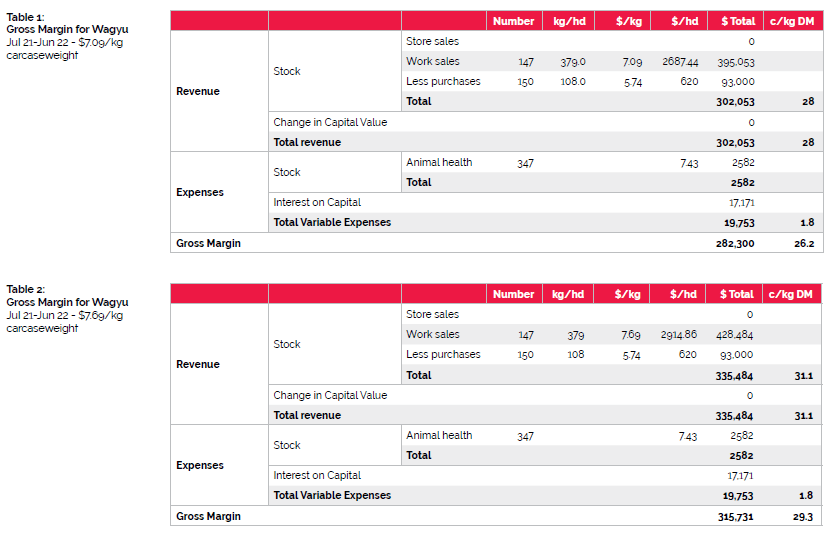A good terminal option
Wagyu has the virtue of being a terminal breed which meshes very well with the Kiwi-cross cow from the dairy industry.

BY: TOM WARD
A recent visit to a farm finishing Wagyu beef highlighted this interesting cattle option.
Wagyu has the virtue of being a terminal breed which meshes very well with the Kiwi-cross cow from the dairy industry. The yellow fat from the Jersey breed has been used to convince customers that the animal really is grass fed. And the Wagyu semen does produce a very good beef animal even as a first cross. Comparing it with purebred Angus steers and heifers, bred for multiple characteristics, the marbling is way ahead in the Wagyu. Best Wagyu suppliers to First Light average a 5.7 marbling score compared to a best of 2 from traditional hill country Angus. The Wagyu animals are slow to mature however, with two-and-a-half years being the age the best marbled beasts are slaughtered. They do not respond to feed deficits, in fact irrigation appears to be desirable. And you would never use Wagyu to breed replacements for your hill country beef herd; they are way too soft.
First Light is a marketing company; it does not own farms, or meat processing works. All Wagyu livestock from the company’s programmes are processed at either Greenlea in the North Island, or ANZCO’s Ashburton plant in the south. I am told this toll processing arrangement with ANZCO works very well for both parties, despite the chain being slowed by the Wagyu processing requirements.
The company started in 2003 as a venison marketer, and in 2011 moved into Wagyu marketing, perceiving a need for very good quality beef. They try to avoid the restaurant trade, dealing directly with retail outlets for 95% of the product, and this has stood them in good stead during the Covid-19 pandemic. About 15% of output goes to New Zealand retailers. The company has a $50 million turnover, about 70% of that is Wagyu. Ownership is 50% farmer suppliers, and 50% the three founding directors.
Slaughter high
About 18,000 Wagyu cattle have been slaughtered each year for the last two years, and after a period of growth, this number is expected to remain stable. There are sufficient breeders and rearers in the system, however suitable finishers are in short supply. The programme appears better suited to irrigated farms however farm management capacity is as important as the property. The stock cannot afford to be pinched, and the First Light company does not want to employ a team of stock agents to manage the farmers.
Wagyu semen is used as a terminal sire only and semen is sourced from a Wagyu stud at Brownrigg Agriculture in Hawke’s Bay. Dairy farmers are pleased to receive $200 for a four-day-old steered bull calf, instead of $30 for the same animal as a bobby.
The aim is for a 650 to 700kg liveweight (LW) steer killing out at 56-57% . That’s an average growth rate of 0.6 to 0.7kg LW/day, i.e. close to a 400kg carcase.
The pricing has remained stable over the last period since Covid-19. The programme, somewhat akin to a dairy grazing contract, is for 12 months, and designed to pay every party fairly. The calf rearer receives $600 for a three month old 100kg LW spring-born calf. A $60/head premium is paid for an autumn-born calf. Eighteen month cattle are sold for $3.10/kg LW for steers and $3.30/kg LW for heifers. All animals are DNA tested.
The finishers are paid for marbling, carcaseweight and company profit (pool payment). Based on the company’s average marbling score of 4.0, they receive a basic $6.30/kg carcaseweight (CW) (plus between 5 and 45c/kg CW for slaughter from May to September). In addition, the company pool payment has been between 30cents and 70cents/kg CW. So the final payment for an average marbling score animal slaughtered in the summer can be $6.80/kg CW, but if the marble score is 5.5 or better (basic price $6.95/kg CW), the final payment, if animals are supplied in winter, could be $8/kg CW. An average marbling score of 5.7 is very good and very few attain higher than that.
The two Farmax gross margins below display the effect of different pricing per kg carcaseweight on return per kg drymatter.
In partnership with Brownriggs and MPI, in late 2020 First Light completed a PGP study investigating the marketing potential for first cross Wagyu beef. Purebred Wagyu beef, a Japanese icon, is well known. The study was to work out how to convince customers to pay a premium for first cross Wagyu beef. There was already the start of a great story with NZ’s very good animal welfare standards, and the use of Wagyu semen reducing the slaughter of bobby calves. The $23 million project received $11 million from MPI, and the remaining balance from First Light and Brownriggs.
The negatives for this enterprise are firstly, the need to control pasture growth and therefore have irrigation, and secondly, the long time the animals need to be retained before they develop superior marbling. This reduces the efficiency significantly.
Senior Angus breeders who I have talked to, suggest the best Angus steers in Australia can attain a similar marbling score as the Wagyu by 26 months of age, slightly earlier than the Wagyu. Most, but not all of those would have been feed-lotted and fed grain.
In the NZ retail space, marbled Wagyu beef is certainly receiving a premium. For example, very good quality, but not marbled, Angus spare ribs retail for $18/kg, this is the same as any amount of beef spare ribs of varying quality in any local supermarket. Wagyu spare ribs however, retail online for $27/kg.




